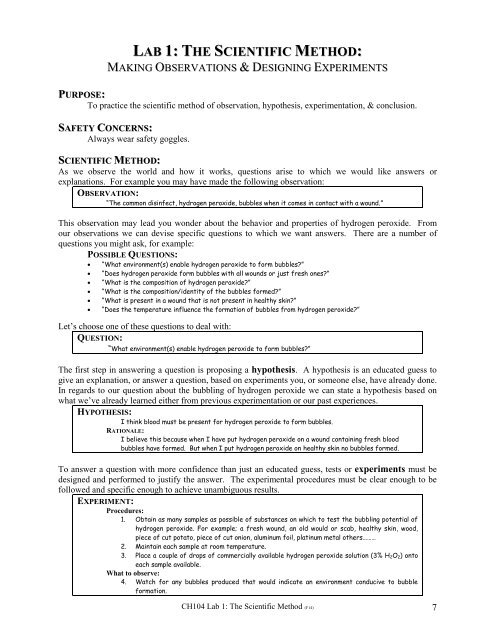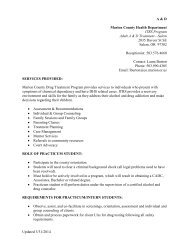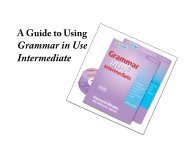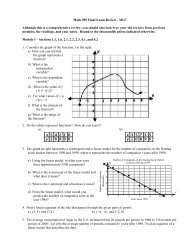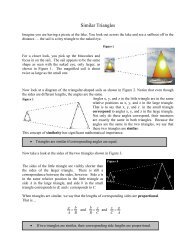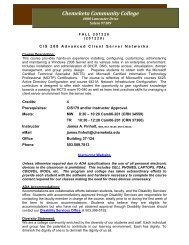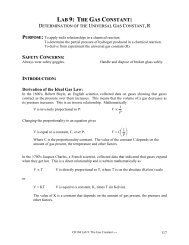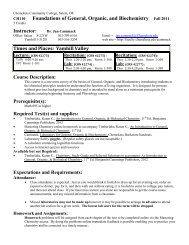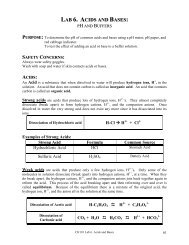1 The Scientific Method
1 The Scientific Method
1 The Scientific Method
You also want an ePaper? Increase the reach of your titles
YUMPU automatically turns print PDFs into web optimized ePapers that Google loves.
LAB 1: THE SCIENTIFIC METHOD:MAKING OBSERVATIONS & DESIGNING EXPERIMENTSPURPOSE:To practice the scientific method of observation, hypothesis, experimentation, & conclusion.SAFETY CONCERNS:Always wear safety goggles.SCIENTIFIC METHOD:As we observe the world and how it works, questions arise to which we would like answers orexplanations. For example you may have made the following observation:OBSERVATION:“<strong>The</strong> common disinfect, hydrogen peroxide, bubbles when it comes in contact with a wound.”This observation may lead you wonder about the behavior and properties of hydrogen peroxide. Fromour observations we can devise specific questions to which we want answers. <strong>The</strong>re are a number ofquestions you might ask, for example:POSSIBLE QUESTIONS:“What environment(s) enable hydrogen peroxide to form bubbles?”“Does hydrogen peroxide form bubbles with all wounds or just fresh ones?”“What is the composition of hydrogen peroxide?”“What is the composition/identity of the bubbles formed?”“What is present in a wound that is not present in healthy skin?”“Does the temperature influence the formation of bubbles from hydrogen peroxide?”Let’s choose one of these questions to deal with:QUESTION:“What environment(s) enable hydrogen peroxide to form bubbles?”<strong>The</strong> first step in answering a question is proposing a hypothesis. A hypothesis is an educated guess togive an explanation, or answer a question, based on experiments you, or someone else, have already done.In regards to our question about the bubbling of hydrogen peroxide we can state a hypothesis based onwhat we’ve already learned either from previous experimentation or our past experiences.HYPOTHESIS:I think blood must be present for hydrogen peroxide to form bubbles.RATIONALE:I believe this because when I have put hydrogen peroxide on a wound containing fresh bloodbubbles have formed. But when I put hydrogen peroxide on healthy skin no bubbles formed.To answer a question with more confidence than just an educated guess, tests or experiments must bedesigned and performed to justify the answer. <strong>The</strong> experimental procedures must be clear enough to befollowed and specific enough to achieve unambiguous results.EXPERIMENT:Procedures:1. Obtain as many samples as possible of substances on which to test the bubbling potential ofhydrogen peroxide. For example; a fresh wound, an old would or scab, healthy skin, wood,piece of cut potato, piece of cut onion, aluminum foil, platinum metal others………2. Maintain each sample at room temperature.3. Place a couple of drops of commercially available hydrogen peroxide solution (3% H 2O 2) ontoeach sample available.What to observe:4. Watch for any bubbles produced that would indicate an environment conducive to bubbleformation.CH104 Lab 1: <strong>The</strong> <strong>Scientific</strong> <strong>Method</strong> (F14) 7
By experimentation we gather firm evidence or results that we can use to either prove or disprove thehypothesis.RESULTS:Substance to TestBubbles formed?YesNoWound with fresh bloodWound with dried bloodHealthy skinWoodCut raw potatoCut raw onionAluminum foilPlatinumExperiments must provide enough evidence to eventually allow reasonable conclusions about whetheror not the initial hypothesis was correct. Often multiple experiments must be performed to be certain thatthe results are repeatable. Sometimes the hypothesis must be revised and then tested repeatedly untilconfident conclusions can be made. Notice the modifications in the following:CONCLUSION:Hydrogen peroxide will form bubbles whenever blood is present but blood is not essential for bubbleformation.RATIONALE:My experiment showed that hydrogen peroxide forms bubbles when dropped on either fresh or driedblood but also forms bubbles when in contact with raw potato, raw onion, and platinum metalwhich do not contain blood.When designing any experiment the potential for errors must be taken into account. Errors occurwhenever any kind of measurement is made as well as when sloppy technique is used. It is impossible toavoid all errors. Each error must be recognized and considered whenever conclusions are made.ERROR ANALYSIS:Although all tests were done at room temperature (25 o C) the bloody wounds andhealthy skin were at body temperature (37 o C). To avoid this difference perhaps one ormore of the following modifications could be made: a drop of blood at room temperature could be dropped into a sample ofperoxide at room temperature. a sliver of dead skin at room temperature could be used instead of skin on aliving body. Other samples could be brought up to 37 o C before being tested with theperoxide.Often, when we do research to answer one question, many more questions arise. One experiment cantherefore lead to many more. Examples of Further Questions that arise from our peroxide experimentcould be:FURTHER QUESTIONS: What is the substance in blood that causes hydrogen peroxide to bubble? Do raw potato and raw onion contain the same substance that is present inblood? Would a cooked potato cause hydrogen peroxide to bubble?XXXXXXXX8CH104 Lab 1: <strong>The</strong> <strong>Scientific</strong> <strong>Method</strong> (F14)
A CHEMICAL REACTION MYSTERY:In this laboratory exercise you will investigate a chemical reaction involving1. sodium bicarbonate (NaHCO 3 ; baking soda, a common antacid)2. calcium chloride (CaCl 2 ; side walk salt, used medically to replace electrolytes)3. phenol red (an indicator used to diagnose kidney function) and4. water (H 2 O)When these four substances are mixed, a change occurs where the original substances (the reactants) getconverted into different substances (the products) with completely different properties. This change iscalled a chemical reaction.Three significant changes may be observed when the above four substances are mixed.OBSERVATIONS:<strong>The</strong>re may be changes in the: physical state, (solid, liquid, or gas) physical properties, (color) or heat energyooIf a chemical reaction gets warm we say that heat energy is released and the reaction issaid to be exothermic.If a reaction gets cooler then heat energy has been absorbed and the reaction isendothermic.)<strong>The</strong>se observations should lead you ask specific questions to which we want answers. <strong>The</strong> questions wewant to ask are:QUESTIONS: What substance or combination of substances, (Sodium bicarbonate, calcium chloride,phenol red, and water) is responsible for the changes in the physical state observed? What substance or combination of substances, (Sodium bicarbonate, calcium chloride,phenol red, and water) is responsible for the changes in the physical properties observed? What substance or combination of substances, (Sodium bicarbonate, calcium chloride,phenol red, and water) is responsible for the changes in the heat energy observed?It is your goal to determine what is responsible for each significant change. This can be done bydesigning different experiments in which you change what substances are mixed. Try mixing only two orthree substances rather than mixing all four.In performing your experiments you will gather results that you will tabulate in order to then makeconclusions.CH104 Lab 1: <strong>The</strong> <strong>Scientific</strong> <strong>Method</strong> (F14) 9
PROCEDURES:ACTIONS:I. CHEMICAL REACTION MYSTERY1. Obtain a quart-sized zip-close plastic bag.2. Place 1 spoonful of sodium bicarbonate 1 (NaHCO 3 ) into one of thecorners of the plastic bag. Observe and record its properties 2 on thereport sheet (Box I2).3. Place 2 spoonfuls of calcium chloride 3 (CaCl 2 ) in a different cornerof the same bag. Note and describe the properties 2 of the calciumchloride (Box I3).4. Mix the sodium bicarbonate and calcium chloride together by gentlytipping the bag back and forth.5. Measure 10 mLs of 0.04% phenol red solution and pour into a smalltest tube or vial. Note and describe the properties. (Box I5). 46. Without spilling, set the small test tube or vial inside the zip-lockbag. Without spilling the vial, carefully squeeze most of the air outof the bag and seal it. 57. With all of your ingredients sealed inside the bag now spill thephenol red solution by tipping over the tube. Mix the contents ofthe bag. This is Trial 1.8. Observe the chemical reaction occurring between the 4 substancesinside the bag and record your observations of the 3 significantchanges. (Box I8).9. Perform further trials by making new combinations of the 4 possiblesubstances to determine which substances are responsible for eachof the 3 changes you observed. 6 Change only what combinationsubstances you use in the reaction. Do not change the amount ofeach substance. 710. Record your observations for each trial in the results column of thereport sheet.NOTES:1 Sodium Bicarbonate iscommon baking soda.2 Physical properties mayinclude its state (whether it issolid, liquid, or gas), its color,its odor, etc. If it is a solidnote the kind of granules orcrystals present that mightdistinguish it from othersolids.3 Calcium Chloride is acommonly used salt formelting ice on frozensidewalks.4 Phenol red solution is acombination of phenol red (asolid) and water.5 <strong>The</strong> bag must be sealed wellso that no liquid or gasescapes.6 Use the same bag but cleanthe zip-close bag and vialbefore doing a newexperiment. Rinse the bagwith water several times andpour the water down the drain.Dry the inside of the bag witha paper towel. Do notpuncture the bag. Rinse thetube or vial.7 Phenol Red solution alwayscontains water so you willnever use phenol red withoutusing water as well. However,you can use water withoutusing phenol red by simplyusing deionized water as oneof your reagents.11. Do as many trials as needed to discover the minimum combinationof substances needed to produce each change.II. CONCLUSIONS12. Make conclusions to answer the questions as to the minimumsubstances necessary to produce each property change.13. Clean-up by rinsing the zip-close bag in the sink.10CH104 Lab 1: <strong>The</strong> <strong>Scientific</strong> <strong>Method</strong> (F14)
LAB 1: THE SCIENTIFIC METHODREPORT:NAME___________________PARTNER_________DATE___I. CHEMICAL REACTION MYSTERYTrial#Reagents to Mix Properties of Reagents Results after MixingDescribe any Changes in:1 1. sodium bicarbonate I2I8(NaHCO 3 )A. Physical State Change:2. calcium chloride I3(CaCl 2 )3. phenol redI5B. Color Change:and4. water (H 2 O)C. Heat Energy Change:Trial#Experiment:(Reagents to Mix)Results:After Mixing describe any Changes:If no change occurs mark X in the space.2 A. Physical State change:B. Color Change:C. Heat Energy change:3 A. Physical State change:B. Color Change:C. Heat Energy change:4 A. Physical State change:B. Color Change:C. Heat Energy change:5 A. Physical State change:B. Color Change:C. Heat Energy change:6 A. Physical State change:B. Color Change:C. Heat Energy change:CH104 Lab 1: <strong>The</strong> <strong>Scientific</strong> <strong>Method</strong> (F14) 11
II. SUMMARY AND CONCLUSIONS:QUESTIONS:A. What substance or combination of substancesis responsible for thechange in physical state?(state the change.______________________)B. What substance or combination of substancesis responsible for thechange in color?(state the change.______________________)C. What substance or combination of substancesis responsible for thechange in the heat energy?(state the change.______________________)CONCLUSIONS:Circle the minimum items required to make the effect.sodium bicarbonate (NaHCO 3 ) phenol redcalcium chloride (CaCl 2 ) water (H 2 O)Circle the minimum items required to make the effect.sodium bicarbonate (NaHCO 3 ) phenol redcalcium chloride (CaCl 2 ) water (H 2 O)Circle the minimum items required to make the effect.sodium bicarbonate (NaHCO 3 ) phenol redcalcium chloride (CaCl 2 ) water (H 2 O)Explanation: How did the use of the scientific method enabled you to make proper conclusions?Error Analysis: Other than “human error” account for any potential pitfalls or errors possible in this experiment even if youdidn’t make them.Further Question(s): Come up with some questions inspired by this lab experience that might generate future experiments.RELATED EXERCISES:1.__ A hypothesis isA. an educated guess. B. the answer to a question. C. an experiment to perform.Reference Search:2. Use the Merck Index to answer the following questions about phenol red.A. List an alternate chemical name _________________________________________B. List the percent composition of it’s elements:Carbon (C) _________% Oxygen (O) _________%Hydrogen (H) _________% Sulfur (S) _________%C. List any medicinal or therapeutic use _______________________________________12CH104 Lab 1: <strong>The</strong> <strong>Scientific</strong> <strong>Method</strong> (F14)


